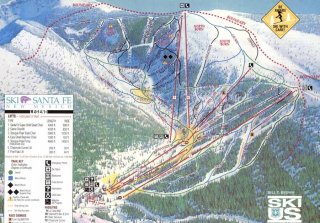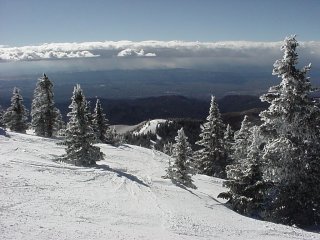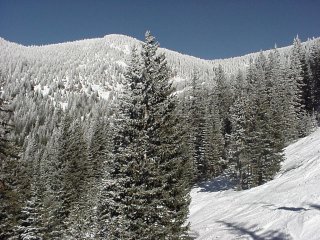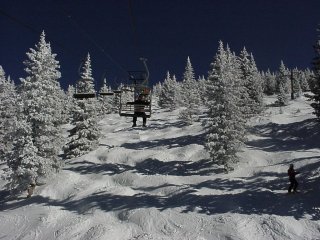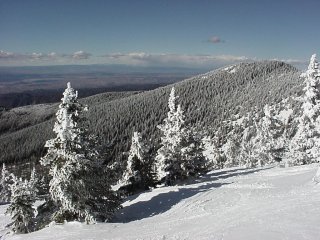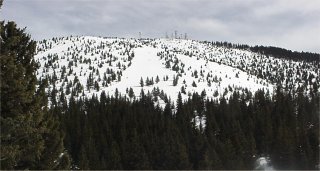Santa Fe, NM – Home to Georgia O’Keeffe, green chiles
and hand-crafted turquoise jewelry, New Mexico’s capital is home to another
gem high in the Sangre de Cristo mountains overlooking the city: Ski Santa
Fe.
n
The family-owned ski resort lies northeast of the city, 15 miles away by car.
Artist’s Road begins climbing out of the city immediately, and continues to
do so as Hyde Park Road along its entire length, twisting and turning as it
rises through various climatic zones. It starts with the piñon and juniper trees
of the arid southwestern desert, and ends with beautiful aspen stands 3,353
vertical feet later, at the base of Ski Santa Fe. The change is startling –
far below, the desert landscape is an endless vista of barren, red clay. Up
here, however, the snowpack is deep, the sun is warm and inviting, and quality
skiing awaits. Topping out at a lofty 12,000 feet, the climate up here is a
world away from the tourist mecca far below, ensuring good snow conditions at
such a southerly latitude.
|
(Click on image to open a full-size trail map in a new |
Ski Santa Fe’s 1,650 vertical feet are serviced by 1 quad chair, 1 triple chair,
2 double chairs, 1 poma and 2 handle tows. Don’t let the statistics fool you,
however, as the mountain skis much bigger than its vertical drop suggests. Tesuque
Peak offers a complete package of widely-spaced trees in an old burn area, steep
glades, wide-open cruisers and gentle cat tracks. The lower Aspen Peak (let’s
not get confused here, folks … we’re still in New Mexico!) is laced with more
cruisers streaming down from its 11,250-foot summit.
The Abruzzo family has created a warm and inviting ski area nestled amongst
the Ponderosa pines and Douglas firs, attracting up to 200,000 visitors annually.
A cozy yet spacious day lodge invites visitors to dally as they boot up before
hopping onto one of the five lifts immediately outside. The well-appointed Chipmunk
Corner children’s center is in a separate building, spitting distance away.
Except for the Chipmunk Corner’s own handle tow, separate from the main body
of the ski area, all lifts from the base ascend to varying locations on Aspen
Peak’s flanks.
After a few quick warm-up runs on the Santa Fe Super Chief Quad Chair, it was
time to stop halfway down to board the Tesuque Peak triple. The parallel Tesuque
Peak Poma only runs on the busiest of days. The summit views are stunning from
12,000 feet, and at one time Santa Fe boasted the highest lift-served skiing
in North America. The vista is estimated to include between 7,000 and 11,000
square miles of desert on a clear day (a frequent occurrence in the southwest)
as one peers southward toward Albuquerque, a 90-minute drive away from the ski
area. Visible on the horizon are the slopes of Sandia Peak Ski Area to the south
(also owned by the Abruzzo family), and Pajarito Mountain to the west. In between,
endless rows of rosy rock formations dot the landscape.
|
|
From the top of Tesuque Peak, skiers and riders face a plethora of options.
One can carve broad arcs down the open spaces of Gayway, a wonderful cruiser,
or tighten things up slightly among the generously-spaced trees of North Burn,
South Burn, or Cornice. If steeper cruising is in mind, Parachute awaits, or
Roadrunner, Pipeline and Molly Hogan are a trio of bumper’s delights. Tequila
Sunrise and Big Rock offer precipitous plunges through tall, straight evergreen
forests, and Avalanche Bowl and Easter Bowl serve up some of the steepest moguls
on the mountain.
Enticed by the unique character of North Burn, I dove right in, finding the
trees perfectly spaced to enjoy high-speed GS turns as the terrain slowly but
steadily steepened. Roughly one-third of the way down, the trees tightened as
I left the burn, and I followed the fall line to the right, passing underneath
the Tesuque Poma and Triple Chair lifts to find the steep bumps of Avalanche
Bowl.
I headed back up, and back down … over and over, never following the same
line twice. For a moderately-sized hill, Ski Santa Fe offers an amazing number
of combinations to enjoy on each run. Among the most scenic trails was Cornice,
another wide-open burn area situated along the ski area’s southern boundary,
where a gentle slope invited speed with abandon, yet beckoned one to stop to
drink in the endless view.
Totemoff’s Bar and Grill, a mid-mountain oasis near the bottom of the Tesuque
Peak lift, offers a welcome respite from the slopes without having to descend
entirely to the base. Also easily accessed from Aspen Peak’s trails, Totemoff’s
sports a generous, south-facing sundeck, an interior cafeteria, or a separate
bar. It is interesting to note that Ski Santa Fe has no bar or lounge in the
day lodge at the base, only at Totemoff’s at mid-mountain.
Immediately below Totemoff’s is Easy street, a broad boulevard that’s perfect
for novice snow sliders, and serviced by its own double chair. Thoughtfully
placed netting prevents speeding skiers from entering the area from above, creating
a quiet refuge in which to learn and practice.
Back at the summit, I gazed longingly toward the south at some truly inviting
terrain. The burn areas at the summit extend south along the ridgeline and beyond
the ski area boundary. A popular lift-served backcountry ski run heads south
outside of the boundary rope and into a drainage which drops the skier to a
hiker’s pullout on Hyde Park Road, several hundred vertical feet below the ski
area. Skiing alone this day, however, it was prudent to save this adventure
for another day when it could be shared with good friends.
Ski Santa Fe’s offerings are about to be further enhanced, if fate looks kindly
on the Abruzzo family. The ski area has applied for a county terrain-management
variance necessary to erect a new $1.5 million triple chair along the Marmot
and Camp Robber trails, rising to just below Deception Peak. This replaces an
old lift dismantled years ago, as the former liftline is clearly still visible.
This new lift will afford access to easy cruising along the northern end of
Tesuque Peak without the burdensome traverse across Sunset from the existing
summit chair. After winning a long battle with expansion opponents dating back
to the early 1990s, the ski company has secured the Forest Service permit to
build the lift, but the county variance is necessary to depart from provisions
prohibiting construction on slopes over 30 percent grade and removal of significant
trees on such slopes. Forest Service approval requires that tree removal be
completed while snow is on the ground to minimize environmental impact. The
ski area hopes to have the new lift in place in time for the 2001-2002 ski season,
along with water-delivery enhancements to the resort’s snowmaking system.
One will find no lodging at the ski area, which is entirely on leased land
within the Santa Fe National Forest. For a pillow, one has to head into the
city of Santa Fe.
DOWN-MOUNTAIN
"It’s more than just vertical feet or acreage … it’s New Mexico,"
quips Steve Lewis of Ski New Mexico, whose office is located in Santa Fe. "When
you walk off the mountain at the end of the day, you’re not in Vail village,
you’re in a place like Santa Fe … you’re in a special place."
|
|
The city of Santa Fe has a rich and varied history. Founded in 1607, it is
the oldest capital city in America, and the oldest European community west of
the Mississippi River. In recent years, Santa Fe has become one of the premier
tourist destinations in the U.S. It is a sophisticated city of 60,000 which
offers 200 restaurants, 150 art galleries, 50 Native American jewelry shops,
13 major museums, and a world famous opera company. Needless to say, Ski Santa
Fe is a destination built to satisfy the skier and non-skier alike, which can
be a real marriage-saver when dragging the entire family along on a ski junket.
Skiers, diners, shoppers, museum goers, history buffs, and more will all be
happy.
You’re sure to find something to suit your palate out of 200 restaurants, and
a great place to start is The Plaza restaurant right on the west side of the
city’s central plaza. Serving an eclectic mix of native New Mexican and Greek
fare since 1918, the decor is an equally eclectic blend of old-style lunch counter
and nouveau chic. Meals are reasonably priced and guaranteed to deliver an authentic
taste of New Mexico’s unique chile pepper creations, which will afford lovely
views of the restaurant’s vintage tin ceiling as you tip back your water glass
in earnest.
|
ONLINE VIDEO View Hot Chiles!,
|
You’ll find the Museum of
Indian Arts and Culture, Wyeth
Hurd Gallery, Museum of
International Folk Art, and of course the Georgia
O’Keeffe Museum among the 13 major museums located in Santa Fe. Most are
housed in and around the center of the city, allowing for an easy walking tour
amongst them.
The Albuquerque International Sunport (Airport) is a mere 60-minute drive away
from the city of Santa Fe along the wide-open I-25 (gotta love 75 m.p.h. speed
limits!), and is serviced by United Airlines, Southwest, Northwest, American,
Frontier, America West, TWA, Continental, Delta, and several smaller regional
carriers. Seven car rental agencies are on-site, or shuttle transportation to
Santa Fe is available through Grey
Line of Albuquerque (1-800-256-8991), Santa
Fe Shuttle (1-888-833-2300) or Sandia Shuttle Express (505-243-3244). For
even quicker access, America West Airlines (from Phoenix) and United Express
(from Denver) both fly directly into Santa Fe Municipal Airport. Santa
Fe Trails provides public bus transportation in and around the city of Santa
Fe.
Looking to combine some unique skiing with some unique cultural opportunities?
Look no further than Santa Fe.

